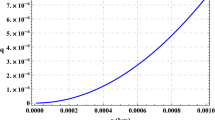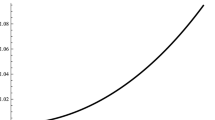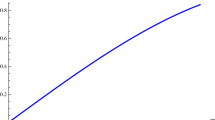Abstract
The aim of this manuscript is to investigate the gravastar model using the \(f(R,\,\Sigma ,\,T)\) strong-gravity and anti-gravity theories, which is posited as a substitute for black holes. The gravastar consists of three regions: the interior, intermediate shell and exterior regions. Inside the interior region, the pressure is equal to the negative density, creating a repulsive force across the thin spherical shell. This shell comprises ultra-relativistic plasma fluids. The Zel'dovich conjecture assumes that the pressure is proportional to the matter–energy density, counterbalancing the repulsive force from the interior region. The exterior region is completely vacuumed and can be defined using a generalised form of the Schwarzschild solution. By applying these specifications, we arrive at numerous precise and singularity-free solutions for the gravastar. These solutions possess several physically valid features within an alternative gravity framework, specifically \(f(R,\,\Sigma ,\,T)\) strong-gravity and anti-gravity. The gravitational Lagrangian is derived from an arbitrary function of the torsion scalar \(\Sigma\) and the trace of the energy–momentum tensor \(T\). In light of \(f(R,\,\Sigma ,\,T)\) recent developments, we can now provide insight into the inner region of the gravastar by considering the interplay between gravity, strong gravity and antigravity forces, which arise from the torsion effect. This approach allows us to analyse important properties that characterise the shell region, such as the proper length, energy content and entropy. Furthermore, the junction, energy and boundary conditions necessary for the production of the thin shell are also discussed in detail. The analysis reveals that the matter density and pressure in the interior region remain constant, while the ultra-relativistic fluid within the shell is denser at the outer boundary than in the inner one. Additionally, the proper length of the shell gradually increases from the interior junction to the exterior junction. Overall, these findings shed light on the mechanisms that govern the behaviour of the gravastar and provide valuable insights into the fundamental principles that govern gravitation and its effects on the Universe.











Similar content being viewed by others
References
A Einstein, Die Feldgleichungen der Gravitation (Sitzungsberichte der Preussischen Akademie der Wissenschaften, Berlin, 1915)
K Schwarzschild, Uber das Gravitationsfeld eines Massenpunktes nach der Einstein'schen Theorie (Sitzungsberichte, Berlin, 1916) Vol. 18
M Carmeli, Classical fields: General relativity and gauge theory (John Wiley & Sons, New York, 1982) pp. 168–171
J N Islam, Rotating fields in general relativity (Cambridge and New York, 1985)
E Mottola, arXiv preprint arXiv:1008.5006 (2010)
P O Mazur and E Mottola, Class. Quant. Grav. 32(21), 215024 (2015)
P Mazur and E Mottola, arXiv:gr-qc/0109035v5, Report number: LA-UR-01–5067 (2001)
P Mazur and E Mottola, Proc. Natl. Acad. Sci. USA 101, 9545 (2004)
M Visser and D L Wiltshire, Class. Quant. Grav. 21, 1135 (2004)
Z Yousaf et al, Phys. Rev. D 100, 024062 (2019)
B M N Carter, Class. Quant. Grav. 22(21), 4551 (2005)
A DeBenedictis et al, Class. Quant. Grav. 23, 2303 (2006)
M A Abramowicz, W Kluzniak and J P Lasota, Astron. Astrophys. 396, 31 (2002)
C B Chirenti and L Rezzolla, Class. Quant. Grav. 24(16), 4191 (2007)
R S De Souza and O Reuven, Phys. Lett. B 705, 292(2011)
A Das, S Ghosh, D Deb, F Rahaman and S Ray, Nucl. Phys. B 954, 114986 (2020)
A Das, S Ghosh, B K Guha, S Das, F Rahaman and S Ray, Phys. Rev. D 95(12), 124011 (2017)
S Ghosh, A D Kanfon, A Das, M J S Houndjo, I G Salako and S Ray, Int. J. Mod. Phys. A 35(04), 2050017 (2020)
S Ray, R Sengupta and H Nimesh, Int. J. Mod. Phys. D 29(05), 2030004 (2020)
M Z Bhatti, Z Yousaf and T Ashraf, Chin. J. Phys. 73, 167 (2021)
K Majeed, G Abbas and A Siddiqa, New Astron. 95, 101802 (2022)
C Cattoen, F Tristan and V Matt, Class. Quant. Grav. 22(20), 4189 (2005)
N Bilić, G B Tupper and R D Viollier, J. Cosmol. Astropart. Phys. 2006(2), 013 (2006)
F S N Lobo and V B A Aaron, Class. Quant. Grav. 24, 1069 (2007)
D Horvat, S Ilijić and A Marunovic, Class. Quant. Grav. 26, 025003 (2008)
K K Nandi et al, Phys. Rev. D 79, 024011 (2009)
B V Turimov, B J Ahmedov and A A Abdujabbarov, Mod. Phys. Lett. A 24, 733 (2009)
F S N Lobo and R Garattini, J. High Energy Phys. 12, 1 (2013)
P Bhar, Astrophys. Space Sci. 354, 457 (2014)
P de Bernardis et al, Nature 404, 955 (2000)
S Hanany et al, The Astrophys. J. 545, 1 (2000)
P J E Peebles and B Ratra, Rev. Mod. Phys. 75, 559 (2003)
T Padmanabhan, Phys. Rep. 380(5–6), 235 (2003)
T Clifton et al, Phys. Rep. 513, 1 (2012)
F I Mikhail and M I Wanas, Proc. R. Soc. London. A. Math. Phys. Sci. 356, 471 (1977)
F I Mikhail, Ain Shams. Sci. Bull. 6, 24 (1962)
M I Wanas, Astrophys. Space Sci. 258, 237 (1997)
M I Wanas, Astrophys. Space Sci. 154, 165 (1989)
M I Wanas, Int. J. Geo. Meth. Mod. Phys. 4, 373 (2007)
M I Wanas and M A Bakry, Int. J. Mod. Phys. A 24(27), 5025 (2009)
M I Wanas, N L Youssef, W El Hanafy and S N Osman, Adv. Math. Phys. 2016, 20 (2016)
M A Bakry and A T Shafeek, Grav. Cosmol. 27(1), 89 (2021)
M I Wanas, Adv. High Energy Phys. 2012, 752613 (2012)
M A Bakry and S K Ibraheem, Grav. Cosmol. 29(1), 19 (2023)
C Brans and H D Robert, Phys. Rev. 124(3), 925 (1961)
J Santos et al, Phys. Rev. D 76, 083513 (2007)
T Harko et al, Phys. Rev. D 84, 024020 (2011)
B J Carr, Astrophys. J. 201, 1 (1975)
M S Madsen et al, Phys. Rev. D 46, 1399 (1992)
T M Braje and R W Romani, Astrophys. J. 580(2), 1043 (2002)
L P Linares, M Malheiro and S Ray, Int. J. Mod. Phys. D 13, 1355 (2004)
Z Yousaf, Phys. Dark Univ. 28, 100509 (2020)
G Darmois, Mémorial des Sciences Mathématiques (Gauthier-Villars, Paris, 1927) Vol. 25
K Lanczos, Ann. der Phys. 379, 518 (1924)
F Rahaman, M Kalam and S Chakraborty, Gen. Relativ. Grav. 38, 1687 (2006)
F Rahaman et al, Class. Quant. Grav. 28, 155021 (2011)
A A Usmani et al, Gen. Relativ. Grav. 42, 2901 (2010)
G A S Dias and P S L Jose, Phys. Rev. D 82, 084023 (2010)
Acknowledgement
The authors extend their appreciation to the Deanship of Scientific Research at Ain Shams University.
Author information
Authors and Affiliations
Corresponding author
Rights and permissions
About this article
Cite this article
Shafeek, A.T., Bakry, M.A. & Moatimid, G.M. Gravastars in \(f(R,\,\Sigma ,\,T)\) strong-gravity and antigravity theories. Pramana - J Phys 97, 189 (2023). https://doi.org/10.1007/s12043-023-02665-3
Received:
Revised:
Accepted:
Published:
DOI: https://doi.org/10.1007/s12043-023-02665-3




